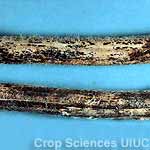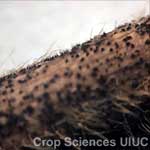Anthracnose


Symptoms:
- Infected seeds may not germinate.
- Dark, sunken cankers can occur on the cotyledons, epicotyl, and radicle of seedlings to cause pre and post-emergence damping-off.
- In older plants, brown cankers may develop on petioles and cause defoliation, and irregular brown spots may develop in a random pattern on stems and pods.
- Infection of pods may result in few or small seeds per pod.
- Stems, pods, and leaves may be infected without showing external symptoms until the weather is warm and moist.
- As plants approach maturity, infected areas may be covered with tiny black spines (setae); these can be seen with a 10X hand lens.
- Anthracnose can reduce yields, decrease stands, and reduce seed quality.
Pathogen Involved:
- Colletotrichum truncatum, Glomerella glycines and other fungi
- These pathogens overwinter in infected crop residue and infected seeds.
Time of Occurrence:
- All season.
Conditions Favoring Disease:
- Warm and moist.
Disease Management:
- Soybean varieties differ in their resistance to anthracnose.
- Plant pathogen-free seed.
- Treatment of infected seeds with a fungicide is recommended.
- Fungicidal sprays may be helpful after bloom.